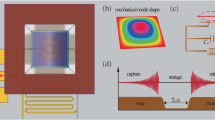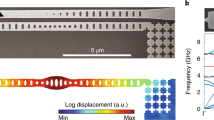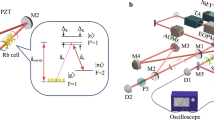Abstract
Quantum memories, capable of controllably storing and releasing a photon, are a crucial component for quantum computers1 and quantum communications2. To date, quantum memories3,4,5,6 have operated with bandwidths that limit data rates to megahertz. Here we report the coherent storage and retrieval of sub-nanosecond low-intensity light pulses with spectral bandwidths exceeding 1 GHz in caesium vapour. The novel memory interaction takes place through a far off-resonant two-photon transition in which the memory bandwidth is dynamically generated by a strong control field7,8. This should allow data rates more than 100 times greater than those of existing quantum memories. The memory works with a total efficiency of 15%, and its coherence is demonstrated through direct interference of the stored and retrieved pulses. Coherence times in hot atomic vapours are on the order of microseconds9, the expected storage time limit for this memory.
This is a preview of subscription content, access via your institution
Access options
Subscribe to this journal
Receive 12 print issues and online access
$209.00 per year
only $17.42 per issue
Buy this article
- Purchase on SpringerLink
- Instant access to full article PDF
Prices may be subject to local taxes which are calculated during checkout





Similar content being viewed by others
References
Kok, P. et al. Linear optical quantum computing with photonic qubits. Rev. Mod. Phys. 79, 135–174 (2007).
Duan, L.-M., Lukin, M. D., Cirac, J. I. & Zoller, P. Long-distance quantum communication with atomic ensembles and linear optics. Nature 414, 413–418 (2001).
Hetet, G., Longdell, J. J., Alexander, A. L., Lam, P. K. & Sellars, M. J. Electro-optic quantum memory for light using two-level atoms. Phys. Rev. Lett. 100, 023601 (2008).
de Riedmatten, H., Afzelius, M., Staudt, M. U., Simon, C. & Gisin, N. A solid-state light–matter interface at the single-photon level. Nature 456, 773–777 (2008).
Schnorrberger, U. et al. Electromagnetically induced transparency and light storage in an atomic Mott insulator. Phys. Rev. Lett. 103, 033003 (2009).
Boozer, A. D., Boca, A., Miller, R., Northup, T. E. & Kimble, H. J. Reversible state transfer between light and a single trapped atom. Phys. Rev. Lett. 98, 193601 (2007).
Gorshkov, A. V., Andre, A., Lukin, M. D. & Sorensen, A. S. Photon storage in Lambda-type optically dense atomic media. II. Free-space model. Phys. Rev. A 76, 033805 (2007).
Nunn, J. et al. Mapping broadband single-photon wave packets into an atomic memory. Phys. Rev. A 75, 011401 (2007).
Camacho, R. M., Vudyasetu, P. K. & Howell, J. C. Four-wave-mixing stopped light in hot atomic rubidium vapour. Nature Photon. 3, 103–106 (2009).
Shor, P. Polynomial-time algorithms for prime factorization and discrete logarithms on a quantum computer. SIAM Rev. 41, 303–332 (1999).
Simon, C. et al. Quantum repeaters with photon pair sources and multimode memories. Phys. Rev. Lett. 98, 190503 (2007).
Choi, K. S., Deng, H., Laurat, J. & Kimble, H. J. Mapping photonic entanglement into and out of a quantum memory. Nature 452, 67–71 (2008).
Nunn, J. et al. Multimode memories in atomic ensembles. Phys. Rev. Lett. 101, 260502 (2008).
Chaneliere, T. et al. Storage and retrieval of single photons transmitted between remote quantum memories. Nature 438, 833–836 (2005).
Julsgaard, B., Sherson, J., Cirac, J. I., Fiurasek, J. & Polzik, E. S. Experimental demonstration of quantum memory for light. Nature 432, 482–486 (2004).
Eisaman, M. D. et al. Electromagnetically induced transparency with tunable single-photon pulses. Nature 438, 837–841 (2005).
Harris, S. E. Electromagnetically induced transparency. Physics Today 50, 36–42 (1997).
Liu, C., Dutton, Z., Behroozi, C. H. & Hau, L. V. Observation of coherent optical information storage in an atomic medium using halted light pulses. Nature 409, 490–493 (2001).
Alexander, A. L., Longdell, J. J., Sellars, M. J. & Manson, N. B. Photon echoes produced by switching electric fields. Phys. Rev. Lett. 96, 043602 (2006).
Kraus, B. et al. Quantum memory for nonstationary light fields based on controlled reversible inhomogeneous broadening. Phys. Rev. A 73, 020302 (2006).
Staudt, M. U. et al. Fidelity of an optical memory based on stimulated photon echoes. Phys. Rev. Lett. 98, 113601 (2007).
Afzelius, M., Simon, C., de Riedmatten, H. & Gisin, N. Multimode quantum memory based on atomic frequency combs. Phys. Rev. A 79, 052329 (2009).
Zhu, Z., Gauthier, D. & Boyd, R. Stored light in an optical fiber via stimulated Brillouin scattering. Science 318, 1748–1750 (2007).
Hosseini, M. et al. Coherent optical pulse sequencer for quantum applications. Nature 461, 241–245 (2009).
Novikova, I., Phillips, N. B. & Gorshkov, A. V. Optimal light storage with full pulse-shape control. Phys. Rev. A 78, 021802 (2008).
Longdell, J. J., Fraval, E., Sellars, M. J. & Manson, N. B. Stopped light with storage times greater than one second using electromagnetically induced transparency in a solid. Phys. Rev. Lett. 95, 063601 (2005).
Kozhekin, A. E., Mølmer, K. & Polzik, E. Quantum memory for light. Phys. Rev. A 62, 033809 (2000).
Surmacz, K. et al. Efficient spatially resolved multimode quantum memory. Phys. Rev. A 78, 033806 (2008).
Collins, O. A., Jenkins, S. D., Kuzmich, A. & Kennedy, T. A. B. Multiplexed memory-insensitive quantum repeaters Phys. Rev. Lett. 98, 060502 (2007).
Acknowledgements
We thank D. Stacey, P. Walther and M.G. Raymer for useful discussions. This work was supported by the Engineering and Physical Sciences Research Council of the UK through the QIP IRC (Quantum Information Processing Interdisciplinary Research Collaboration: GR/S82716/01) and project EP/C51933/01. K.F.R. and V.O.L. were supported by the Marie-Curie-Network EMALI (Engineering, Manipulation and Characterization of Quantum States of Matter and Light). B.J.S. gratefully acknowledges support from the Natural Sciences and Engineering Research Council of Canada and from the Royal Society. I.A.W. was supported in part by the European Commission under the Integrated Project Qubit Applications (QAP) funded by the Information Society Technologies directorate as contract no. 015848, and the Royal Society.
Author information
Authors and Affiliations
Contributions
K.F.R. built the experiment, with initial assistance from V.O.L., and collected the data. K.F.R., J.N. and B.J.S. contributed to the theoretical analysis. N.K.L. assisted with design and analysis of the coherence measurements. K.C.L., N.K.L. and D.J. added useful insights, and I.A.W. conceived the experiment. The manuscript was written by K.F.R. with input from B.J.S., J.N., N.K.L. and I.A.W.
Corresponding author
Ethics declarations
Competing interests
The authors declare no competing financial interests.
Supplementary information
Rights and permissions
About this article
Cite this article
Reim, K., Nunn, J., Lorenz, V. et al. Towards high-speed optical quantum memories. Nature Photon 4, 218–221 (2010). https://doi.org/10.1038/nphoton.2010.30
Received:
Accepted:
Published:
Issue Date:
DOI: https://doi.org/10.1038/nphoton.2010.30
This article is cited by
-
Fast, noise-free atomic optical memory with 35-percent end-to-end efficiency
Communications Physics (2023)
-
Rare-earth quantum memories: The experimental status quo
Frontiers of Physics (2023)
-
A theoretical analysis on quantum memory parameters in ultracold \(^{87}\)Rb and \(^{133}\)Cs alkali species using EIT protocol in the presence of structured light
Quantum Information Processing (2022)
-
Studying the effect of fluctuating environment on intra-atomic frequency comb based quantum memory
Scientific Reports (2021)
-
Temporal Wheeler’s delayed-choice experiment based on cold atomic quantum memory
npj Quantum Information (2020)



